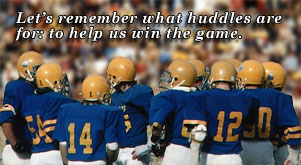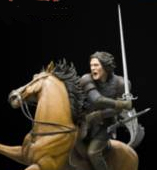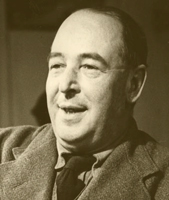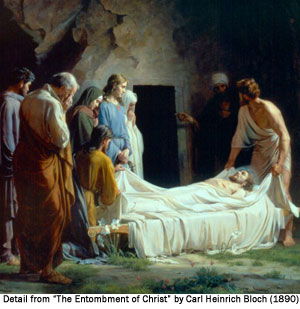The Christian's Call to Huddle
Monday, May 19, 2008Limited Huddle Time
National Football League rules assign a maximum of 40 seconds between plays, which means that huddles have to be quick and efficient.  Imagine the following four teams.
Imagine the following four teams.
Red Team
After the play, most of the players stagger and limp toward the quarterback, arriving late and talking among themselves. Two of the players don't huddle up at all--one lines up again while the other just stands on the field, paying no attention to the game. The frustrated quarterback begins to describe the next play, but two of the players doze off, while two more are distracted by the other team. Furthermore, because three more haven't stopped talking among themselves, they haven't clearly heard the instructions. The only person paying attention is the linebacker. Which of the following would best describe this team?
- [ ] Superbowl contenders.
[ ] Didn't make the playoffs but still had a good year.
[ ] Losers and slackers, nine of which should be kicked off the team.
The entire team hustles in to the huddle and listens quietly to the quarterback. Each huddle is a little different. In one huddle, the quarterback expounds on the rules of the game, such as staying within the boundaries, what constitutes a penalty, how many points for a field goal, etc. In another huddle, he explains that the football must be carried in the right direction and not dropped to make a touchdown. In a third huddle, the quarterback explains the importance of coming to the huddle every time the huddle comes together, and how wicked it is not to huddle. In a fourth huddle, he tells the team how important it is to become a team member and goes over the contract-signing procedures. Oops! Our 40 seconds are almost up. Better line up for the play. What do you think of this team?
- [ ] Likely to win a championship.
[ ] Likely to get stomped four quarters of each game.
All of the players on this team arrive at the huddle on time and dressed in their brand new uniforms. Their helmets and pads are adjusted properly. The quarterback explains the play clearly and concisely as everyone listens carefully. When the huddle is over, they all run off the field to the locker room, ready for all of their individual pursuits--shopping, eating out, playing with their kids, going water-skiing. They've had their football for the week in that huddle, which was a little longer than they are comfortable with, but they can handle it, as long as the quarterback doesn't make a habit of it. What are the chances this team will make the play-offs?
- [ ] 50/50.
[ ] 1 in 100.
[ ] They won't make the playoffs. Never ever!
Players move quickly into the huddle, though some are sore and some are bleeding. They listen as the quarterback explains the play. A few ask pertinent questions, but most nod that they understand. The huddle takes most of the 40 seconds, but no time there is wasted. When the players break, each goes to his assigned spot ready for the snap. None of them are thinking about how great the huddle was. They are focused on the play. There will be another huddle later on, when the team is farther down the field. How well will this team do in the upcoming season? Would you care to be a devoted fan?
It's Not Just Huddles
We Christians play as a team in the greatest game of
 our lives. Our assemblies are our huddles. Huddles are essential to the game of football, but they are not the game itself. Let's make it to the huddles, yes. But let's remember what huddles are for: to help us win the game. Let's structure the huddles to accomplish that goal. Then when the huddle is over, let's play together as a team and win this!
our lives. Our assemblies are our huddles. Huddles are essential to the game of football, but they are not the game itself. Let's make it to the huddles, yes. But let's remember what huddles are for: to help us win the game. Let's structure the huddles to accomplish that goal. Then when the huddle is over, let's play together as a team and win this!I understand this is a simplistic view. The Christian assembly is multi-dimensional. But still, we are not the fans in the stands; we are the players on the field. And if that is true, huddles are not the game. The game is our entire lives. The assemblies have their proper place, and they are essential to winning. But what happens in the huddle is only secondary to what happens in the game. We have to be the best we can be. Our opponent is out for blood.
Want to go deeper?
Here are some passages to study in more depth about the purposes of Christian assemblies:
- 1 Corinthians 11:17-34 -- to participate in the Lord's Supper and proclaim His death (see also Acts 20:7).
- 1 Corinthians 14:3-5, 12, 17, 26 -- to build up one another.
- Acts 2:42-47 -- to learn, to pray, to share needs, to praise God.
- Hebrews 10:24-25 -- to stimulate each other to love and good deeds and to encourage each other.
Here are passages that describe the purpose of the Christian's life:
- Matthew 5:13-16 -- to illuminate, to preserve, to cause other to praise God.
- Luke 9:23 -- to deny self, to take up your cross, and to follow Jesus.
- Philippians 1:21 -- to live with Christ at the center of our being (see also Galatians 2:20).
- Colossians 3:1-4 -- to focus your thinking on Christ and "things above."
- Philippians 2:12-13 -- to allow God to work on you and through you.
- Many other passages, such as Romans 12:1-2; Ephesians 2:8-10; 1 Timothy 2:1-4; Titus 2:11-14; and Titus 3:8.
Now compare the two lists. Are they incompatible or complementary? Even the passage about the Lord's Supper has a theme of team spirit and unity to it. The modern concept of individualism and self-imposed isolation is contrary to the Scriptures.
Ecclesiastical quarterbacks will say they are forced to preach Purple-Team sermons because that's where their "players" are. That could well be true. But those players have to change into the Gold Team. And the sooner the better.
Recommended for purchase:
Wes Roberts & Glenn Marshall. Reclaiming God's Original Intent for the Church (2004) – Character, servanthood, discipleship, and walking in the Spirit were the focus of the primitive church. Is it ours?
Keith Wilhite. Preaching with Relevance (2001) – 10 strategies for crafting and presenting sermons that will help listeners understand the meaning of the passage, affirm the sermon's message, and apply God's truth.
Gail Ramshaw. Every Day and Sunday, Too (1997) – Explores, for children and adults, the relationship between the Christian's daily life and the Sunday assembly.
As always, I don't necessarily recommend everything these books teach. Part of "going deeper" is developing your own spiritual discernment. It's good to "taste-test" before swallowing.
Labels: christian assembly, sermon, theology of preaching, theology of worship


 "Prince Caspian" audiobook
"Prince Caspian" audiobook it told the waiter (a slave back then) that the person was not finished eating and would be right back. This in contrast to the wadded napkin that signaled the meal was over and that the diner had left for good. The argument is that Jesus folded his napkin to show (drum roll) He's coming back!
it told the waiter (a slave back then) that the person was not finished eating and would be right back. This in contrast to the wadded napkin that signaled the meal was over and that the diner had left for good. The argument is that Jesus folded his napkin to show (drum roll) He's coming back!